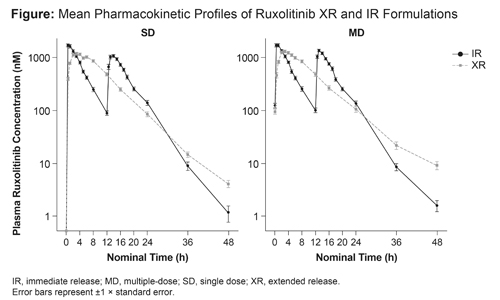
Contributions
Abstract: PB1706
Type: Publication Only
Session title: Myeloproliferative neoplasms - Clinical
Background
Ruxolitinib is currently dosed twice-daily (BID) using an immediate release (IR) formulation for the treatment of myelofibrosis, polycythemia vera, and acute graft-versus-host disease. An extended release (XR) formulation of ruxolitinib was developed to allow once-daily (QD) dosing. Five XR tablet strengths were developed, containing 10, 20, 30, 40, and 50 mg of ruxolitinib, free base equivalent.
Aims
To establish the bioequivalence of the highest strength of ruxolitinib XR tablets (50 mg) dosed QD to the highest strength of ruxolitinib IR tablets (25 mg) dosed BID, following a single dose and at steady-state.
Methods
This phase 1, open-label, randomized, 2-period, 2-way crossover study in 60 healthy adult participants evaluated single-dose and steady-state bioequivalence of ruxolitinib 50 mg XR tablets compared to ruxolitinib 25 mg IR tablets. In treatment period 1, participants were randomly assigned to receive ruxolitinib XR or ruxolitinib IR; following a 9-day washout period, participants entered treatment period 2 and crossed over to receive the other formulation (IR or XR, respectively). Each treatment period consisted of single-dose and multiple-dose parts. In the single-dose part of the study, participants received either ruxolitinib XR 50 mg as a single dose or ruxolitinib IR as 2 doses of 25 mg each administered 12 hours apart; in the multiple-dose part of the study, participants received ruxolitinib XR 50 mg QD or ruxolitinib IR 25 mg BID for 4 days (4 doses and 8 doses, respectively). Standard non-compartmental pharmacokinetic (PK) analysis methods were used to calculate PK parameters. Average bioequivalence analysis was performed for the determination of geometric mean ratio (GMR) and 90% confidence interval (CI) for the comparison of PK parameters between the test formulation (XR) and the reference formulation (IR). Bioequivalence criteria required the point estimate and 90% CI limits to lie within the range of 0.8-1.25. The measures used for bioequivalence evaluation included Cmax, C24h, AUC0-t, and AUC0-∞ from the single-dose part, and Cmax,ss, C24h, and AUC0-24h from the multiple-dose part. Safety and tolerability were assessed by monitoring the frequency and severity of adverse events; performing physical examinations; and collecting vital signs, 12-lead electrocardiograms, and clinical laboratory data.
Results
The PK profiles of ruxolitinib XR and IR for single dose and multiple-dose parts are shown in Figure 1. The 50 mg ruxolitinib XR tablet formulation met the bioequivalence criteria for AUC parameters both following a single dose and at steady-state; bioequivalence was not achieved for Cmax or C24h. All treatments were well tolerated and no new safety findings were observed with administration of ruxolitinib XR.

Conclusion
Ruxolitinib XR 50 mg tablets dosed QD is bioequivalent to 25 mg IR tablets dosed BID, based on AUC parameters. No new safety concerns were observed with ruxolitinib XR.
Keyword(s):
Abstract: PB1706
Type: Publication Only
Session title: Myeloproliferative neoplasms - Clinical
Background
Ruxolitinib is currently dosed twice-daily (BID) using an immediate release (IR) formulation for the treatment of myelofibrosis, polycythemia vera, and acute graft-versus-host disease. An extended release (XR) formulation of ruxolitinib was developed to allow once-daily (QD) dosing. Five XR tablet strengths were developed, containing 10, 20, 30, 40, and 50 mg of ruxolitinib, free base equivalent.
Aims
To establish the bioequivalence of the highest strength of ruxolitinib XR tablets (50 mg) dosed QD to the highest strength of ruxolitinib IR tablets (25 mg) dosed BID, following a single dose and at steady-state.
Methods
This phase 1, open-label, randomized, 2-period, 2-way crossover study in 60 healthy adult participants evaluated single-dose and steady-state bioequivalence of ruxolitinib 50 mg XR tablets compared to ruxolitinib 25 mg IR tablets. In treatment period 1, participants were randomly assigned to receive ruxolitinib XR or ruxolitinib IR; following a 9-day washout period, participants entered treatment period 2 and crossed over to receive the other formulation (IR or XR, respectively). Each treatment period consisted of single-dose and multiple-dose parts. In the single-dose part of the study, participants received either ruxolitinib XR 50 mg as a single dose or ruxolitinib IR as 2 doses of 25 mg each administered 12 hours apart; in the multiple-dose part of the study, participants received ruxolitinib XR 50 mg QD or ruxolitinib IR 25 mg BID for 4 days (4 doses and 8 doses, respectively). Standard non-compartmental pharmacokinetic (PK) analysis methods were used to calculate PK parameters. Average bioequivalence analysis was performed for the determination of geometric mean ratio (GMR) and 90% confidence interval (CI) for the comparison of PK parameters between the test formulation (XR) and the reference formulation (IR). Bioequivalence criteria required the point estimate and 90% CI limits to lie within the range of 0.8-1.25. The measures used for bioequivalence evaluation included Cmax, C24h, AUC0-t, and AUC0-∞ from the single-dose part, and Cmax,ss, C24h, and AUC0-24h from the multiple-dose part. Safety and tolerability were assessed by monitoring the frequency and severity of adverse events; performing physical examinations; and collecting vital signs, 12-lead electrocardiograms, and clinical laboratory data.
Results
The PK profiles of ruxolitinib XR and IR for single dose and multiple-dose parts are shown in Figure 1. The 50 mg ruxolitinib XR tablet formulation met the bioequivalence criteria for AUC parameters both following a single dose and at steady-state; bioequivalence was not achieved for Cmax or C24h. All treatments were well tolerated and no new safety findings were observed with administration of ruxolitinib XR.

Conclusion
Ruxolitinib XR 50 mg tablets dosed QD is bioequivalent to 25 mg IR tablets dosed BID, based on AUC parameters. No new safety concerns were observed with ruxolitinib XR.
Keyword(s):


